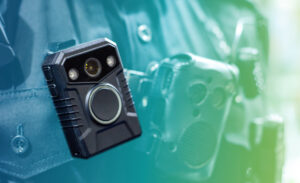How Are Body-Worn Cameras Working?
Posted
April 11, 2022
Share:
Efforts to increase transparency are arguably the most prominent aspect of police reform efforts. Legislatures are creating regulatory changes that require the disclosure of police data to contribute to a better-informed public and shed light on police operations and tactics. A central component of these efforts involves leveraging a still-developing technology: body-worn cameras (BWC).
How we got here

From a tech perspective, the development of BWCs essentially tracks with broader trends in consumer electronics towards miniaturization and reduced production costs. Experimentation with primitive BWCs began in the 1990s, following the relatively widespread adoption of dash cams in radio cars. BWCs did not become commonplace until the late 2000s, coinciding with the popularization of smartphone technology which also allowed the public to record video and audio from a handheld device. Now it is common for BWCs to be able to record in high definition with audio and, in many cases, in low-light conditions.
This tech comes with a cost. The Police Executive Research Forum (PERF) published a research paper that estimates one camera costs between approximately $1,200 and $3,200 per year. The reason for calculating the expense as a yearly cost is that the upfront purchase price of a camera is often relatively modest compared to the ongoing costs of training, maintenance, and data management associated with deploying a BWC over the course of a year. The variation in these figures is influenced by an agency’s policy regarding how long data is kept, whether it is stored locally or in a cloud system, and who is able to access it.
As the tech has become more accessible, the prevalence of BWCs has exploded. Approximately 32% of departments were using them in 2013. Just five years later that figure had risen to 47% across all agencies. Notably, 80% of large departments, typically with greater access to resources than smaller agencies, have now deployed BWCs.
Grants have helped offset costs for departments adopting body-worn cameras. Typically, when they are mandated by state or local laws, those governing bodies also provide funding in the form of grants or budget line items for purchase and upkeep. This year, the Department of Justice is accepting grant applications from law enforcement and corrections agencies through May. Additionally, recognizing the limited budgets of agencies with fewer sworn staff, the DOJ has specially designated additional resources of approximately $7.5M for smaller, rural agencies.
What body-worn cameras promise
The arguments for deploying BWCs fall into several categories:
Increased transparency: This notion relies on the fundamental understanding of BWCs as essential to creating an unbiased record of a police/civilian interaction or other policing operation. This is, of course, only the case when the cameras are switched on during an encounter and even then they can only capture events from the vantage point of the officer wearing the camera, leading to debate over a bias in the footage.
The “Civilizing Effect”: One study showed that when both parties to a police/civilian interaction knew they were being recorded that those involved tended to act more civil to one another. Generally, officers are thought to be more polite and less terse with citizens while those citizens are also less likely to act aggressively or flee an encounter. Early studies showed some positive movement on the number of complaints after BWCs were introduced.
Evidence: The scene of a traffic collision or crime often puts a lot of demands on an officer – from securing the scene itself and gathering statements to possibly detaining a suspect or rendering aid. Even those with the sharpest memories can forget the details of an incident in a hectic situation. Video of an entire encounter used as evidence can provide meaningful context and background at trial that written reports and statements cannot.
Training resource: Beyond transparency efforts and as evidence, BWC footage has been shown to be quite useful to departments as a training aid. As many as 94% of agencies currently engage in the practice, leveraging the footage for scenario-based training, performance review (especially with new officers), and for gap-analysis to determine where additional training is necessary.
What the research shows
On the surface, the reasons to deploy BWCs seem as obvious as they are abundant, representing a win/win scenario for both officers and the communities they serve. As research creates new evidence to guide decision-making on BWCs, however, a more complex and nuanced picture is emerging.
Early studies have shown dramatic reductions in use-of-force incidents and citizen complaints, as much as 88% in the landmark Rialto Study. Research published by the University of Chicago in 2021 shows that, among the departments surveyed, citizen complaints dropped by 17% and that use-of-force incidents saw a nearly 10% decline across the fatal and non-fatal categories.
The complexity arrives in the disparity between complaints and actual officer behavior. Researchers published a meta-analysis of available research in 2021, aggregating and analyzing the findings of 70 studies examining the effectiveness of BWCs. While calling for additional research, the topline of this analysis suggests there is not yet conclusive evidence that BWCs improve officer safety. Additionally, BWCs have not been shown to have a statistically significant effect on arrests, traffic stops, assaults on officers, or other types of citizen/officer interactions.
Why the difference in research findings? Broadly speaking, for every study finding a decrease in citizen complaints there may be another one, studying another department as a research sample, finding that complaints did not significantly change. What’s more, complaints are not necessarily a conclusive indicator of behavior in the field. Furthermore, with recent high-profile events in policing, changes in officer behavior and citizen reactions may be driven by factors unrelated to the use of BWCs.
The debate over and study of the efficacy of BWCs shows no signs of slowing down. Further research is needed to identify why some agencies are able to deploy BWCs and see dramatic and positive results whereas others don’t see as much change in their outcomes. One possible explanation for these disparities has do with other risk management and accountability practices like early intervention, data transparency efforts, and duty to intervene policies. Though there will always be a need for more data to base these decisions on, there is a developing consensus that BWCs still represent a net benefit to both officers and citizens.
Related Posts
Ready to Experience the Benchmark Difference?
Benchmark Analytics and its powerful suite of solutions can help you turn your agency’s challenges into opportunities. Get in touch with our expert team today.



